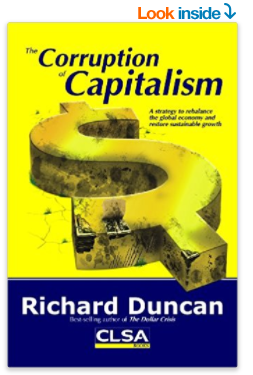“The Corruption of Capitalism” is Richard Duncan’s easy to read, thoroughly researched book, providing a lucid and original argument about the causes of the current global financial instability. This is his second book published in 2009, only a year after the financial miasma that he had correctly predicted in his first book “The Dollar Crisis” written in 2005 (which will be subject of another separate review).
The full title of the book is “Corruption of Capitalism: A strategy to rebalance the global economy and restore sustainable
growth” which might sounds a bit ambitious for such a thin and slender book, but he pulls it off. Duncan offers his readers a panorama of current international economic scene and what he calls the New Depression, based on a close reading of the past, and offers a few advices for the future, all of this in about 200 pages. In more than one sense it could have also be named: “A Brief History of 20th Century Economics and how overspending has always gotten us into trouble!”
Let start with his conclusions:
“Over the course of little more than one generation, the global economy has been transformed by three developments:
– The emergence of dollar standard, with its inability to prevent or correct trade imbalance;
– Globalization, which caused a 90% drop in marginal cost of labor and made large trade imbalances between high-wage and low-wage countries inevitable within the dollar standard framework; and
– Paper-money creation on a previously unimaginable scale, undertaken primarily by the central banks of low-wage, trade-surplus countries for purpose of perpetuating their competitive advantage.
These developments are linked. The process of globalization was accelerated by the US’s extraordinary trade deficit. Large-scale paper-money creation would have led to hyperinflation, had globalization not brought about a collapse in wage rates. The US would have been unable to finance its trade deficits, had its trading partners not created equivalent of trillions of dollars of  paper money and bought US debt instruments.
paper money and bought US debt instruments.
Together, these changes produced the greatest economic boom in history.Unfortunately, the boom was not built on sustainable foundations. It was built on debt. The expansion of private-sector debt in the US drove the worldwide economic upsurge but eventually bankrupted the US private sector”
He further adds: “In reality, however, Capitalism had been corrupted by the creation of paper money and enormous government debt. Capitalism is an economic system based on private ownership of the means of production, within which the role of the government is limited. The economic system that has evolved in the US over the past 40 years, in which the government creates the money, manipulates interest rates and directs the economy through debt-financed fiscal “stimulus”, has little in common with the capitalism. It is better described as statism, an economic system in which the government controls the means of production.
The transformation of the US economic system from capitalism to statism was exposed by the government’s policy response to the economic breakdown that began in 2008. Had the capitalist forces of creative destruction been allowed to operate, the financial industry would have been annihilated and the global economy would have collapsed. Instead the state intervened to prop us both through yet more debt and paper-money creation.”
How does he arrive at these conclusions?
In chapter 5, titled “Monetary LSD” we read: “The bubble that caused the New Depression began on 15 August 1971, when President Nixon repudiated the United States’ obligation to back its currency with gold.” Nixon’s action effectively destroyed the Bretton Woods financial agreement that had underpinned unprecedented growth of Western economies though 50’s and 60’s. That act simultaneously destroyed the international monetary system and severed the last real link between paper dollars and gold. From that moment on money would be worth only as much as currency speculators determined it to be worth. In the post-Bretton Woods world, it gradually became apparent that there was no limit to how much money could be created. Moreover, as time went by, it also became clear there were fewer and fewer constraints on the number of financial entities that could create it. The new volatile age of paper money had begun. The title of that chapter is from Valery Giscard d’Estaing, then the French Minister of Economy and Finance, who like everyone else could not conceive of an international trading system in which the currencies of all countries were in constant flux relative to one another and to gold, Giscard d’Estaing characterized flexible exchange rates as “a sort of monetary LSD”
Understandably resort to paper money gave some breathing space to US economy, but at the same time it created a multiplicity of crisis all its own. Starting in the 1970’s international credit flows began to destabilize the global economy. One country after another was plunged into crisis as dollar denominated credit from abroad produced short term booms followed by longer lasting busts. The crisis that began in Latin America in the 1980’s, re-erupted in Mexico in 1994, engulfed Asia in 1997 and spread to Russia the next year, hit New York in 1998.
In chapter 3 we get an overview of the global economy and what Duncan calls “ A crisis of imbalance” by analyzing economies of China, Japan, Germany, Korea, India, the Oil market and attempts at Quantitative easing, the global savings glut he shows us why the crisis is global and we’re ALL stuck in it. But as usual with Duncan it’s not all doom and gloom, he’s also able to identify the possibilities for moving out of crisis, he concludes that chapter by saying: “Something good could result from the New Depression after all. Central banks around the world are creating paper money to keep assets prices inflated, to support aggregate demand and to prevent the collapse of the global financial sector. If they allocated this conjured-up money wisely, they could work miracles.”






